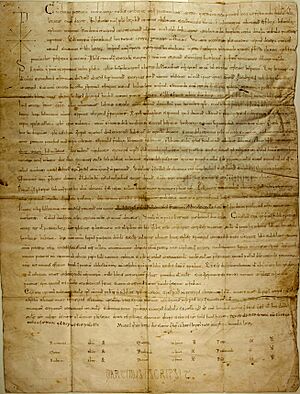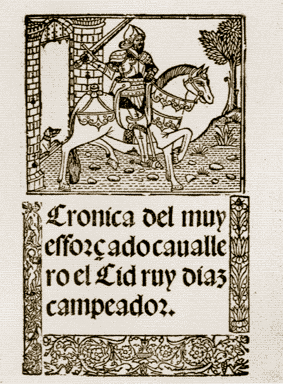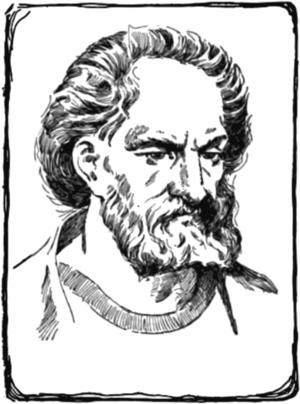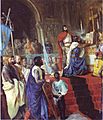El Cid facts for kids
Quick facts for kids Rodrigo Díaz de Vivar (El Cid) |
|
|---|---|
| Prince of Valencia | |

Statue of El Cid in Burgos, Spain
|
|
| Prince of Valencia | |
| Reign | 1094 – 1099 |
| Coronation | 1094 |
| Predecessor | Ibn Jahaf |
| Successor | Jimena Díaz |
| Born | Rodrigo Díaz c. 1043 Vivar, Burgos |
| Died | 10 July 1099 (aged around 56) Valencia |
| Burial | Burgos Cathedral |
| Spouse | Jimena Díaz |
| Issue | Diego Rodríguez Cristina Rodríguez María Rodríguez |
| Father | Diego Laínez |
| Signature | |
Rodrigo Díaz de Vivar (born around 1043 – died July 10, 1099) was a famous knight and military leader from Castile in medieval Spain. He fought for both Christian and Muslim armies during his life. He earned the Arabic nickname al-sīd, which became El Cid (meaning "the lord"). He was also known as El Campeador in Spanish, which means "the valiant" or "master of the battlefield."
El Cid was born in Vivar, a small village near the city of Burgos. He led his loyal knights and became very powerful in the eastern part of the Iberian Peninsula in the late 1000s. He took control of the city of Valencia from Muslim rule for a short time during the Reconquista (the Christian reconquest of Spain). He ruled Valencia as its Prince from 1094 until his death in 1099. After he died, his wife, Jimena Díaz, ruled the city until 1102, when Muslim forces took it back.
El Cid became famous for serving both Christian and Muslim rulers. After his death, he became a celebrated national hero in Spain. He is the main character of the most important medieval Spanish epic poem, El Cantar de mio Cid. This poem shows him as the perfect medieval knight: strong, brave, loyal, fair, and religious. El Cid is still a popular Spanish folk hero and national symbol today. His life and adventures are remembered in many stories and movies.
Contents
Who Was El Cid?
El Cid was born Rodrigo Díaz around 1043. His family was part of the lower nobility. He grew up in the court of Ferdinand the Great, a powerful king. Later, he served Ferdinand's son, Sancho II of León and Castile.
Rising to Power Under King Sancho
El Cid became the commander and royal standard-bearer (a high-ranking military leader) for Castile when Sancho became king in 1065. El Cid led Castilian armies in battles against Sancho's brothers, Alfonso VI of León and García II of Galicia. He also fought against Muslim kingdoms in al-Andalus (Muslim Spain). He became known for his great military skills in these battles. His victories helped expand the territory of Castile and Sancho's kingdom.
Challenges Under King Alfonso
In 1072, King Sancho was murdered. Since Sancho had no children, his brother Alfonso became king. This was a difficult time for El Cid because he had helped remove Alfonso from power earlier. Even though El Cid continued to serve the new king, he lost his high position in the court. People were suspicious of him. Finally, in 1081, King Alfonso sent him away from the kingdom. This was called being "exiled."
El Cid's Time in Exile
Being exiled did not stop El Cid. He went to the Taifa of Zaragoza, a Muslim kingdom, where he was welcomed. In 1081, El Cid offered his military skills to the Muslim king of Zaragoza, Yusuf al-Mu'taman ibn Hud. He served both this king and his son, al-Musta'in II. He was given the title El Cid (meaning "The Master") and became a leading figure in their army. This army included different groups like Muwallads, Berbers, and Arabs.
While in exile, El Cid became famous again as a brilliant military leader. He won many battles against Muslim rulers and their Christian allies. He even defeated a large Christian army led by King Sancho Ramírez of Aragon.
Return to Christian Service
In 1086, a powerful army from North Africa, called the Almoravids, invaded Spain. They caused a major defeat for Castile. This made King Alfonso realize he needed El Cid's help. Alfonso put aside his anger and asked El Cid to return. El Cid agreed and soon found himself fighting for his former lord again.
Over the next few years, El Cid focused on the city of Valencia. He worked mostly on his own, separate from King Alfonso. He supported Muslim rulers who were against the Almoravids. He slowly gained more control over Valencia. By 1092, the Muslim ruler of Valencia, Yahya al-Qadir, became his ally and paid him taxes.
When the Almoravids caused an uprising that led to Al-Qadir's death, El Cid attacked Valencia. The city finally fell in 1094. El Cid then created his own independent kingdom on the Mediterranean coast of Spain. He ruled over a diverse society with both Christians and Muslims, and he had their support.
El Cid's Final Years
El Cid spent his last years fighting the Almoravid Berbers. He gave them their first big defeat in 1094, near Valencia. He continued to fight them until he died. El Cid remained undefeated in Valencia. However, his only son and heir, Diego Rodríguez, died fighting the Almoravids in 1097 while serving King Alfonso.
El Cid died on July 10, 1099. After his death, his wife, Jimena Díaz, became the ruler of Valencia. But she was eventually forced to give up the city to the Almoravids in 1102. Jimena fled to Burgos, Castile, in 1101, bringing El Cid's body with her. He was first buried in a monastery, but his body now rests in the Burgos Cathedral.
What Do Cid and Campeador Mean?
The name El Cid comes from the Arabic word sîdi or sayyid, which means "lord" or "master." It's thought that the Arabs or Spanish Muslims who served in his army might have called him this. The Christians then used a similar-sounding word. Some historians believe he got this title after his victories while serving the King of Zaragoza between 1081 and 1086. Others think he received it after he conquered Valencia in 1094. The name "Meo Çidi" first appears in a poem called Poema de Almería, written between 1147 and 1149.
The title "Campeador" comes from the Latin words campi doctor, which means "master of the battlefield." Rodrigo Díaz was called "Campeador" during his lifetime. A document he signed in 1098 shows him using the Latin phrase "Ego Rudericus Campidoctor" (I Rodrigo Campeador). He probably earned this title during battles fought for King Sancho II of Castile against his brothers. While "Cid" wasn't used in his time, many Christian and Arab records, and even documents he signed, call him "Campeador." The full name "Cid Campeador" first appeared around 1195 in a text called Linaje de Rodrigo Díaz.
El Cid's Family
El Cid married Jimena Díaz in the mid-1070s. She was from an important family in Asturias. Stories say that El Cid was amazed by her beauty when he first saw her.
El Cid and Jimena had two daughters, Cristina and María, and one son. Their son, Diego Rodríguez, sadly died fighting against the Muslim Almoravids in 1097.
Both of El Cid's daughters married into noble families. Cristina Rodríguez married Ramiro, a lord and grandson of a king. Her son, El Cid's grandson, later became King García Ramírez of Navarre. The other daughter, María, is said to have first married a prince of Aragon and later Ramon Berenguer III, a count of Barcelona.
El Cid as a Warrior

El Cid was known for his clever battle tactics. Before battles, he often had books by famous Roman and Greek writers about military strategies read aloud to his troops. This was for both fun and inspiration.
El Cid's army had a unique way of planning. They would hold "brainstorming" sessions before each battle to discuss different tactics. They often used surprising strategies. For example, they might wait for the enemy to be scared and then attack suddenly. Or they might distract the enemy with a small group of soldiers before the main attack. El Cid was open to ideas from his soldiers.
Babieca, El Cid's Horse
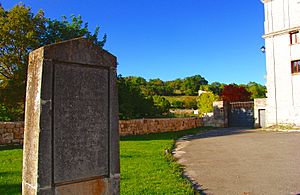
Babieca was El Cid's famous warhorse. There are several stories about how El Cid got Babieca. One legend says that El Cid's godfather, a monk, gave him a choice of a horse from a herd. El Cid picked a horse that his godfather thought was weak, calling it "Babieca!" (meaning "stupid!"). So, that became the horse's name.
Another story says that in a competition to become King Sancho's champion, El Cid was given the king's finest horse, Babieca. This version says Babieca was a highly trained and loyal warhorse from the royal stables. The name might also come from the Babia region in Spain.
No matter how he got him, Babieca became a great warhorse. He was famous among Christians and feared by El Cid's enemies. El Cid loved Babieca so much that he supposedly asked to be buried with him. Babieca is mentioned in many stories and historical documents about El Cid.
El Cid's Swords
El Cid had two famous swords: Tizona and Colada.
A sword believed to be Tizona was once shown in the Army Museum in Toledo. In 1999, tests on a small piece of the blade showed it was made in Muslim Córdoba in the 11th century. It even contained a special type of steel called Damascus steel. In 2007, a region in Spain bought the sword for a lot of money, and it is now on display at the Museum of Burgos.
El Cid in Popular Culture
El Cid has inspired many stories, songs, and movies. The most famous is the Cantar de mio Cid, an epic poem from the 12th century. It tells a partly fictional story of his life and helped make him a legendary hero in Spain.
- In the 17th century, the Spanish writer Guillén de Castro wrote a play called Las Mocedades del Cid. A French writer, Pierre Corneille, then based one of his most famous plays, Le Cid, on it.
- Many Spanish writers during the Romantic period also wrote about El Cid.
- In music, Jules Massenet wrote an opera called Le Cid in 1885.
- In movies, El Cid was played by American actor Charlton Heston in the 1961 epic film El Cid.
- In 2020, Amazon Prime Video released a Spanish TV series about El Cid, with Jaime Lorente playing the main role.
- There's also an animated series from 1980 called Ruy, the Little Cid, based on El Cid's childhood.
- El Cid appears in several video games, including Age of Empires II: The Conquerors, Medieval: Total War, Rise of Kingdoms, and Crusader Kings II.
Images for kids
-
General view of the 1954 Juan Cristóbal González Quesada's statue of El Cid in Burgos
-
In 2008, this El Cid statue made by Ángel Gil Cuevas was placed in Mecerreyes, at the path of the "Camino del Cid".
-
El Cid medallion (1733–34) at the Plaza Mayor, Salamanca
See also
 In Spanish: Rodrigo Díaz de Vivar para niños
In Spanish: Rodrigo Díaz de Vivar para niños


